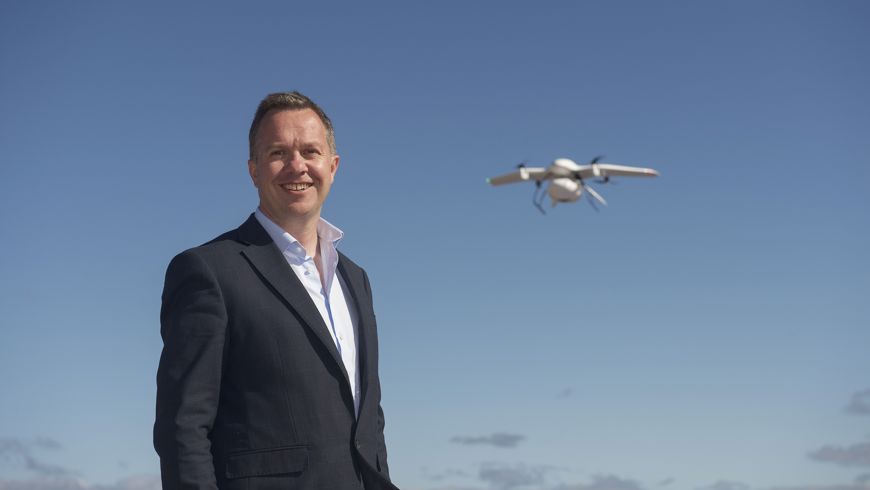
A World First as Drone delivers medication to the Aran Islands
NUI Galway makes Aviation History by Completing the World’s First Diabetes Drone Mission from the Irish mainland to the Aran Islands
The first autonomous Beyond Visual Line of Sight (BVLOS) Vodafone connected Vertical Take Off and Landing (VTOL) drone delivery of prescription medication and collection of patient blood sample for diabetes care

Professor Derek O’Keeffe (Project Lead) Professor of Medical Device Technology, NUI Galway and Consultant Physician, Galway University Hospitals.
Monday, 16 September, 2019: NUI Galway and partners completed the world’s first autonomous beyond visual line of sight (BVLOS), vertical take-off and landing (VTOL) drone delivery of diabetes prescription medications (insulin, glucagon) and collection of a patient blood sample between Connemara Airport and Inis Mór, Aran Islands. The Internet of Things (IoT) connected drone delivery was supported by the Irish Aviation Authority, operated in between commercial flights and was in contact with air space regulators at all times, showing the possibility of future deliveries of this kind within planned drone corridors.
The NUI Galway led #DiabetesDrone project was run in partnership with several industry experts and stakeholders including, Skytango, Survey Drones Ireland, Wingcopter, Vodafone Ireland and global healthcare company Novo Nordisk. Dr Kevin Johnson, University of Limerick provided expert insight into state-of-the-art drone technology and Dr Spyridoula Maraka, University of Arkansas for Medical Sciences, USA, outlined the health care delivery issues involved in this innovative project. Novo Nordisk, the world’s largest insulin manufacturer, supplied the glucagon and insulin for the mission.
It is crucial that people with diabetes have access to their lifesaving medicine at all times, which is often challenging in remote geographic regions and in times of natural disasters. Recent severe weather events, including storms Emma and Ophelia, demonstrated a clear need to develop the capability to deliver insulin and other critical medications (such as glucagon) in times of crisis.
Project lead, Professor Derek O’Keeffe, Professor of Medical Device Technology, NUI Galway and Consultant Physician, Galway University Hospitals, said: “Climate change means that these types of severe weather events are becoming more prevalent. Individuals and communities in rural locations can become isolated for days after a severe weather event and an emergency may arise where patients can run out of their medicine. Therefore, it is incumbent on us to develop a solution for these emergencies, which addresses the clinical, technical and regulatory issues before a sentinel event occurs. To date medical drones have demonstrated success, for example in delivering blood, defibrillators and human organs for transplant. This #DiabetesDrone project represents another milestone in the use of drones to improve patient care.”
The drone was launched from Connemara Airport using a combination of software - one for the pre-flight check-list and one for the mission flight. The drone was connected via Vodafone Ireland’s IoT network and it flew a pre-planned flight path using Q Ground Control software. This software allowed the connection of the primary cellular communications and backup satellite communications to be displayed, allowing the SUA Pilots on both sites to track the progress of the aircraft. This is very important, as is the need to implement the BVLOS emergency procedures. Once airborne the whole flight was monitored by the SUA Pilots from Survey Drones Ireland and Wingcopter. The Skytango software platform was used to manage checklists from all parties pre-launch and record the compliance of the operation from both an aviation and a medical regulatory standpoint, as well as inform stakeholders of the launch in realtime.
For more information about the project, visit: www.diabetesdrone.com and on Twitter @DiabetesDrone #DiabetesDrone
To see the historic #DiabetesDrone delivery from the Irish mainland to the Aran Islands, see: https://www.youtube.com/watch?v=vJ6HSbn3C2g
Published September 2019
